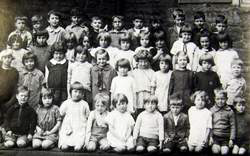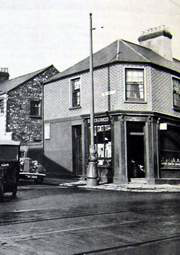Abandoned Communities ..... Temperance Town
After the initial construction work had been completed in Temperance Town a relatively small area of vacant land was left at the western end of Wood Street. Proposals for both a school and a church were put forward, and there was lively argument about which should be approved. At first it seemed that higher priority would be given to the educational needs of the area, and the Wood Street Board Schools, one for girls, one for boys, and one for infants, were opened in January 1879.
The wonderful design for the schools, by architect George E Robinson, can be seen on the People’s Collection Wales website.
The proponents of a new church did not give up. By 1888 they had been allowed to proceed with the building of St Dyfrig’s church, squeezed in very close to the schools. The schools must have suffered a major loss of playground space and a reduction of natural lighting on the western side. A few years later, in 1895, the catchment area of St Dyfrig’s was declared a separate parish, and Rev. H A Coe was appointed its first vicar.
More on the history of St Dyfrig’s church, including a description of the procession and ceremony that marked the laying of the memorial stone, can be found in the Cardiff Times, 27 July 1940, page 5.
Religious services were sometimes also conducted at the Temperance Hall. In due course the hall was acquired by the Congregational denomination and converted into a church, the largest Congregational church in south Wales.
Temperance Town was demolished in 1937. I will say a few things about some aspects of life in Temperance Town during the ten years or so before its demolition, and then we will look at the debates, decisions, and planning processes within the Cardiff Corporation that led up to its removal.
The Western Mail Cardiff Street Directory for 1937 lists the names of all householders in Temperance Town at that time. It also gives the name of everyone running a business, predominantly in Wood Street, but also in a few premises elsewhere in the district. There were several confectioners, outfitters, and newsagents. M Bradbury, a boot repairer, occupied 52 Wood Street, Mrs M Goldstein, a ladies hairdresser, was at number 60, and M Garelick, wireless supplies, at number 45. Leslie Jacobs was an outfitter at 22, and also a pawnbroker next door at 24. C Pascos had a grocery shop at number 15, and J Markovitch was a baker and grocer at 42, on the corner with Eisteddfod Street.
Cardiff Street Directories from before World War II can be consulted at Cardiff Central Library, or at Glamorgan Archives. A photograph of C Pascos standing at the entrance to his grocery shop at 15 Wood Street can be seen in Volume 17 of Stewart Williams, Cardiff Yesterday, 1987.
The decade leading up to 1937 had been a period of economic hardship in much of Great Britain. An additional factor affecting the prosperity of Cardiff was the rapid shift from coal to oil as a source of energy. Between 1913 and 1935 the amount of coal exported from Cardiff fell by over 50%. A lot of people living in Temperance Town would have been unemployed, or would have had to rely on intermittent opportunities for casual labour.
In 1935 there were 135 houses on the south side of Wood Street. Those houses were occupied by 880 people, many of whom were sub-tenants. At an average of six and half people per house it is clear there must have been considerable overcrowding. One address where overcrowding was especially acute was 2 Havelock Street, the home of Mark and Maud Tipples. Marilyn Tipples, wife of one of the grandsons of Mark and Maud, has told me they had 10 children, though the youngest had died very young in 1927. One of their older sons, Marilyn’s father-in-law, was married in 1932. He and his wife continued to lodge with Mark and Maud, and by 1937 they had added three more children to the family.
Memories of life at Wood Street school are recorded in Bill Twamley’s Cardiff and Me Sixty Years Ago, Starling Press Ltd, 1984. The headmaster of the boys’ school was Mr Richards, “a short gent with a ginger moustache”. Episodes of caning are vividly recalled. Some boys hardly flinched, while others “gave us a great pantomime”. After returning to their seats pupils used various methods to reduce the intensity of the pain they continued to suffer.
Boys at the school were shocked when two of their friends, Goodman and Parsons, were drowned while swimming in the River Taff. School was interrupted so that pupils could watch the funeral cortege pass along Wood Street and enter St Dyfrig’s church. Visitors to the school included a member of the Temperance Society who gave a lecture on the evils of alcohol, and someone from the Education Authority who spoke on the subject "The Educational Ladder", reminding his listeners that if they studied hard at school they might get to university.
Bill Twamley adds comments on some of the local shops. At Mrs Evans, the sweetshop, the best bargains were the tiger nuts, plentiful and long lasting. At Markovitch the grocer, mentioned earlier, there was a barrel of pickled herrings just inside the door. Children used to shout in "Any cooked ham today?", but were disappointed that “the little old man with the pointed grey beard” never tried to chase them.
The wonderful design for the schools, by architect George E Robinson, can be seen on the People’s Collection Wales website.
The proponents of a new church did not give up. By 1888 they had been allowed to proceed with the building of St Dyfrig’s church, squeezed in very close to the schools. The schools must have suffered a major loss of playground space and a reduction of natural lighting on the western side. A few years later, in 1895, the catchment area of St Dyfrig’s was declared a separate parish, and Rev. H A Coe was appointed its first vicar.
More on the history of St Dyfrig’s church, including a description of the procession and ceremony that marked the laying of the memorial stone, can be found in the Cardiff Times, 27 July 1940, page 5.
Religious services were sometimes also conducted at the Temperance Hall. In due course the hall was acquired by the Congregational denomination and converted into a church, the largest Congregational church in south Wales.
Temperance Town was demolished in 1937. I will say a few things about some aspects of life in Temperance Town during the ten years or so before its demolition, and then we will look at the debates, decisions, and planning processes within the Cardiff Corporation that led up to its removal.
The Western Mail Cardiff Street Directory for 1937 lists the names of all householders in Temperance Town at that time. It also gives the name of everyone running a business, predominantly in Wood Street, but also in a few premises elsewhere in the district. There were several confectioners, outfitters, and newsagents. M Bradbury, a boot repairer, occupied 52 Wood Street, Mrs M Goldstein, a ladies hairdresser, was at number 60, and M Garelick, wireless supplies, at number 45. Leslie Jacobs was an outfitter at 22, and also a pawnbroker next door at 24. C Pascos had a grocery shop at number 15, and J Markovitch was a baker and grocer at 42, on the corner with Eisteddfod Street.
Cardiff Street Directories from before World War II can be consulted at Cardiff Central Library, or at Glamorgan Archives. A photograph of C Pascos standing at the entrance to his grocery shop at 15 Wood Street can be seen in Volume 17 of Stewart Williams, Cardiff Yesterday, 1987.
The decade leading up to 1937 had been a period of economic hardship in much of Great Britain. An additional factor affecting the prosperity of Cardiff was the rapid shift from coal to oil as a source of energy. Between 1913 and 1935 the amount of coal exported from Cardiff fell by over 50%. A lot of people living in Temperance Town would have been unemployed, or would have had to rely on intermittent opportunities for casual labour.
In 1935 there were 135 houses on the south side of Wood Street. Those houses were occupied by 880 people, many of whom were sub-
Memories of life at Wood Street school are recorded in Bill Twamley’s Cardiff and Me Sixty Years Ago, Starling Press Ltd, 1984. The headmaster of the boys’ school was Mr Richards, “a short gent with a ginger moustache”. Episodes of caning are vividly recalled. Some boys hardly flinched, while others “gave us a great pantomime”. After returning to their seats pupils used various methods to reduce the intensity of the pain they continued to suffer.
Boys at the school were shocked when two of their friends, Goodman and Parsons, were drowned while swimming in the River Taff. School was interrupted so that pupils could watch the funeral cortege pass along Wood Street and enter St Dyfrig’s church. Visitors to the school included a member of the Temperance Society who gave a lecture on the evils of alcohol, and someone from the Education Authority who spoke on the subject "The Educational Ladder", reminding his listeners that if they studied hard at school they might get to university.
Bill Twamley adds comments on some of the local shops. At Mrs Evans, the sweetshop, the best bargains were the tiger nuts, plentiful and long lasting. At Markovitch the grocer, mentioned earlier, there was a barrel of pickled herrings just inside the door. Children used to shout in "Any cooked ham today?", but were disappointed that “the little old man with the pointed grey beard” never tried to chase them.
Two
Pupils at Wood Street Infants’ School, 1925
J Markovitch, the baker and grocer at 42 Wood Street

